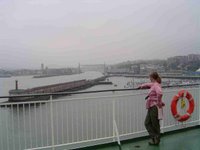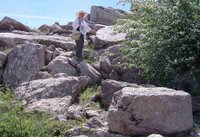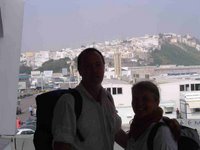 Today, Wednesday, May 10th, we've driven from Spain's deep south to Madrid, very near its geographical centre. We left Cortijo La Joya in thick mist and watched the cloud rolling off the mountain tops in a huge standing wave as we drove down into Antequera and the motorway. We've spent a very happy month at the cortijo with its little community of friendly residents and travellers. It's been a great base for our explorations and a warm and welcoming home to return to at the end of a day. Antequera was sunny, and we took a last opportunity to photograph its police station that looks like a film-set for Zorro!
Today, Wednesday, May 10th, we've driven from Spain's deep south to Madrid, very near its geographical centre. We left Cortijo La Joya in thick mist and watched the cloud rolling off the mountain tops in a huge standing wave as we drove down into Antequera and the motorway. We've spent a very happy month at the cortijo with its little community of friendly residents and travellers. It's been a great base for our explorations and a warm and welcoming home to return to at the end of a day. Antequera was sunny, and we took a last opportunity to photograph its police station that looks like a film-set for Zorro! Our lunch stop was at the extreme northern end of Andulacia, where the road crosses a steep mountain pass and emerges in Castilla La Mancha, which stretches out, flat as a tortilla, for mile upon mile, although the monotony is relieved occasionally by
Our lunch stop was at the extreme northern end of Andulacia, where the road crosses a steep mountain pass and emerges in Castilla La Mancha, which stretches out, flat as a tortilla, for mile upon mile, although the monotony is relieved occasionally by gigantic black bulls standing by the roadside. In earlier times, the pass was the holdout of an Andalucian bandit who "escorted" travellers safely through the dangerous landscape. They weren't allowed to refuse the offer of an escort; if they did, the landscape was likely to become much more dangerous very quickly. We've ensconced in a Formule Hotel in a commercial area on the outskirts of Madrid and had our supper in a truckers' restaurant. Here we got a good 3 course meal with wine and coffee for 17 Euros (total), joining the other customers watching Seville playing Middlesborough in football in UEFA Cup Final. The young and efficient waiter here worked out straight away that we're British from our stumbling order in Spanish, and so he served us in carefully pronounced Spanish himself, listening out for our mistakes and correcting us gently as we struggled along. The other diners meanwhile, truckers to a man, were relishing their own supper, one man to a table, being served just as thoughtfully. Having said that, one of them really got under the waiter's skin. He had convex ears (always a bad sign, I've found) and continually asked for more of everything, holding up a hand like a child at school to catch the waiter's attention. When he got to the dessert he changed his mind repeatedly about what he wanted. Finally he decided that he wanted a peach; the waiter said he thought there weren't any, but that he'd go and look. Meanwhile the diner got up and wandered around, looking for a peach, too. Finally, he found a bowl of fruit, including two peaches, on a high shelf above the dessert display cabinet. With a huge grin, he took first one, then the second, and helped himself to a plate and knife before going back to the table. When the waiter returned to report that there were, indeed, no peaches, the man pointed delightedly at his plate and began to tuck in. For the rest of the time he sat there munching and slurping them as loudly as he could, turning around occasionally to let everyone see that he had TWO peaches, not just ONE. Just before we left, a big friendly giant, just like
gigantic black bulls standing by the roadside. In earlier times, the pass was the holdout of an Andalucian bandit who "escorted" travellers safely through the dangerous landscape. They weren't allowed to refuse the offer of an escort; if they did, the landscape was likely to become much more dangerous very quickly. We've ensconced in a Formule Hotel in a commercial area on the outskirts of Madrid and had our supper in a truckers' restaurant. Here we got a good 3 course meal with wine and coffee for 17 Euros (total), joining the other customers watching Seville playing Middlesborough in football in UEFA Cup Final. The young and efficient waiter here worked out straight away that we're British from our stumbling order in Spanish, and so he served us in carefully pronounced Spanish himself, listening out for our mistakes and correcting us gently as we struggled along. The other diners meanwhile, truckers to a man, were relishing their own supper, one man to a table, being served just as thoughtfully. Having said that, one of them really got under the waiter's skin. He had convex ears (always a bad sign, I've found) and continually asked for more of everything, holding up a hand like a child at school to catch the waiter's attention. When he got to the dessert he changed his mind repeatedly about what he wanted. Finally he decided that he wanted a peach; the waiter said he thought there weren't any, but that he'd go and look. Meanwhile the diner got up and wandered around, looking for a peach, too. Finally, he found a bowl of fruit, including two peaches, on a high shelf above the dessert display cabinet. With a huge grin, he took first one, then the second, and helped himself to a plate and knife before going back to the table. When the waiter returned to report that there were, indeed, no peaches, the man pointed delightedly at his plate and began to tuck in. For the rest of the time he sat there munching and slurping them as loudly as he could, turning around occasionally to let everyone see that he had TWO peaches, not just ONE. Just before we left, a big friendly giant, just like  Mongo in the film Blazing Saddles, came in to eat. he got a seat at the front, right by the television, and the biggest salad I've ever seen, served super-quick. While everyone else was drinking wine or small glasses of beer, he got a huge glassful of beer that must have been about three quarters of a litre. We could have done with his help later (read on). By the way, Seville are 1-0 in the lead as I write. On the short walk back to the hotel, two very nice young men in a swish-looking car asked the way out of the trading complex (well, actually, one was in the car, the other looked as if he'd just got back from asking directions). We stopped and said that we didn't know the area - we should have known better, it was such an obvious set-up - and things got exciting very quickly. The man on the side of the road grabbed Faith's bag and tried to make off with it into the car. She held on very tight, though, and pulled back, yelling at him at the top of her voice. I grabbed the bag, too, and buffeted, trying to push him away. His accomplice in the car turned and shouted to him, and our attacker put his hand inside his jacket as if to pull out a weapon. I don't know whether or not he had one - or was simply going through the motions so that we'd let go -
Mongo in the film Blazing Saddles, came in to eat. he got a seat at the front, right by the television, and the biggest salad I've ever seen, served super-quick. While everyone else was drinking wine or small glasses of beer, he got a huge glassful of beer that must have been about three quarters of a litre. We could have done with his help later (read on). By the way, Seville are 1-0 in the lead as I write. On the short walk back to the hotel, two very nice young men in a swish-looking car asked the way out of the trading complex (well, actually, one was in the car, the other looked as if he'd just got back from asking directions). We stopped and said that we didn't know the area - we should have known better, it was such an obvious set-up - and things got exciting very quickly. The man on the side of the road grabbed Faith's bag and tried to make off with it into the car. She held on very tight, though, and pulled back, yelling at him at the top of her voice. I grabbed the bag, too, and buffeted, trying to push him away. His accomplice in the car turned and shouted to him, and our attacker put his hand inside his jacket as if to pull out a weapon. I don't know whether or not he had one - or was simply going through the motions so that we'd let go -  because I managed to land a good high kick in his ribs (bless you, Berkshire Bedlam!) on top of Faith's efforts, and he gave up; we were making a lot of noise! I yelled to Faith to run, which she did surprisingly quickly, and I was close behind. The guy had bundled himself in to the car, though, and was gone in a flash. Back at the hotel, wobbly but in one piece, and with all our belongings still intact, we reported what we could to a passing security patrol. It's appalling how little we'd been able to take in, though; a newish sporty black car, possibly a Mercedes, possibly a BMW; two young men, one black - the driver, one white - the attacker. Seville has just won the game, 4-0 (3 more goals scored in about 10 minutes near the end), and, knowing Seville, there'll be no sleep there tonight!
because I managed to land a good high kick in his ribs (bless you, Berkshire Bedlam!) on top of Faith's efforts, and he gave up; we were making a lot of noise! I yelled to Faith to run, which she did surprisingly quickly, and I was close behind. The guy had bundled himself in to the car, though, and was gone in a flash. Back at the hotel, wobbly but in one piece, and with all our belongings still intact, we reported what we could to a passing security patrol. It's appalling how little we'd been able to take in, though; a newish sporty black car, possibly a Mercedes, possibly a BMW; two young men, one black - the driver, one white - the attacker. Seville has just won the game, 4-0 (3 more goals scored in about 10 minutes near the end), and, knowing Seville, there'll be no sleep there tonight!Thursday, May 11th. The TV news at breakfast showed Seville's celebrations. The whole city out in the streets cheering, crying, singing - and they've only just finished a week of Semana Santa followed by a week of Feria! The news headline was 'Trabajar sin dormir!' - work wothout sleep - and they interviewed a number of very bleary office workers, restaurateurs etc who were convinced that they would survive the day on good, strong coffee. So did we; the next section of the journey took us across the most fearsomely flat country that I've ever seen until, at last, we arrived in the Pays Basque and the Cantabrian Mountains. Here, we could well have been in the Alps. Chalets, green mountain fields and forests of fir trees on steep valley sides.

We stayed in an Etap Hotel this time, in the hilly Bilbao suburb of Arrigorriaga. The whole area is bilingual - Basque (Euskara - all K's and X's) and Spanish. We went for a walk and saw the whole town (more or less) collecting the children from school, had a quick drink in Cafe Coyote - themed on Wile E. Coyote, even down to the light fittings shaped like bundles of ACME TNT, and then had a meal in Restaurant Capitaine Utzigaine (who he?). Meanwhile, outside, it thundered and rained. A good, honest mountain storm. Just before bed, we checked the news. Seville is still partying!
Friday, May 12th. We' as marvelled at Bilbao's transporter bridge (they do say it's even older than the one in Newport,
 the scurvy knaves) and now, hearties, we is safely aboard ye good ship Pride of Bilbao, bound for Portsmouth, aye. Biscay (o), is fair calm, and ' tis hardly a wobble we's feelin' as she ploughs her way north'ard. We ' as seen 'ordes o' dolphins (common an' striped, dam'yer eyes!), fin whales an' a sei whale. I 'is 'ardly able to keep me trusty 'arpoon from a'quiverin'! We 'is finishin' the day eatin' our supper in the ship's Carvery as the sun is settin' an' 'dolphins is bow-ridin' ahead o' us. I is wipin' a salty tear from my (good) eye jus' thinkin' on it - but don't 'ee think I is goin' soft mind!
the scurvy knaves) and now, hearties, we is safely aboard ye good ship Pride of Bilbao, bound for Portsmouth, aye. Biscay (o), is fair calm, and ' tis hardly a wobble we's feelin' as she ploughs her way north'ard. We ' as seen 'ordes o' dolphins (common an' striped, dam'yer eyes!), fin whales an' a sei whale. I 'is 'ardly able to keep me trusty 'arpoon from a'quiverin'! We 'is finishin' the day eatin' our supper in the ship's Carvery as the sun is settin' an' 'dolphins is bow-ridin' ahead o' us. I is wipin' a salty tear from my (good) eye jus' thinkin' on it - but don't 'ee think I is goin' soft mind!By the way: a bottle of wine to the first reader who correctly identifies the source of this post's title.








 Jose Tragabuches
Jose Tragabuches








